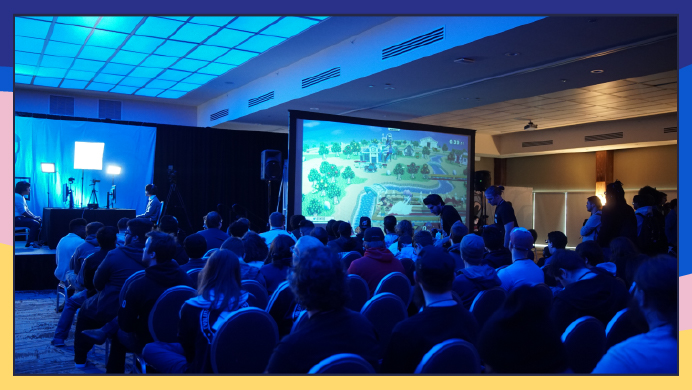When creating corporate training videos, sparking real interest instead of the usual jaw-breaking yawns is a challenge. In this chapter we’re going to provide you with some general tips for drawing your learners in and getting them not only to pay attention to your corporate training videos…but to want to pay attention. Then we’ll narrow our focus to some specific design and filming tips that will enhance the visual appeal and polish of your final product.
Give it character
Assigning a specific character or tone to a training video is an excellent means of igniting ancillary emotions, ideas, and cognitive connections that help solidify the content in memory. This short animation, for example, utilizes a mix of audio and visual techniques to establish a clearly defined character that complements the safety message. The music is reminiscent of the soundtrack of a classic western film, hinting at the polarly opposite nature of the two main characters. The color scheme starkly highlights the roles of protagonist and antagonist, and the plot escalates in intensity, starting off with fairly benign consequences for careless actions that quickly become much more severe. This western showdown characterization heightens the impact of the video, and the music, color choices, and creatively rendered animation provide a level of appeal not often found in typical training videos. Taking it a step further, the content suggests a broader conceptual reach than it explicitly depicts – a strategy supported by the undeniable visual appeal. Making characterization a focus will set your corporate training videos apart.
Tell a story
Who doesn’t love a good story? Crafting a script that has a cohesive plot and creating a certain level of intrigue can really draw in your audience. If you have some dry material, give it some situational context. As the great Mary Poppins once said, “a spoonful of sugar makes the medicine go down.” The bits of information that you want the learner to retain will be much easier to remember if the viewer can associate them with a memorable narrative. A good story is entertaining and much more appealing than a list of facts. One of the key drivers for this animated video about a new learning theory model is the fantastic story.
Integrate sound and music
Sound and music appeal to learners on a primal level. The inclusion of sound effects draws the learner in closer to the content and the universe you’ve created in your video. Highlighting a specific moment with a sound is an easy way to deliver emphasis. Sounds can generate context to such an extent that the visuals can often become secondary. For example, the sound of birds chirping will signal that the scene is in an outdoor, natural setting, even if there are no trees or other greenery on screen. Don’t neglect sound and music in your training videos, and make selections that correspond to the overall tone. Wanting to get people revved up over a new company policy? Pick something upbeat. Need to convey the serious nature of compliance regulations? Incorporate a subtle, sober tune. Sound and music can generate powerful emotional responses, making learners more receptive to the message your corporate training video is trying to convey.
You’ve decided on a defined character, you’ve developed a great story, and you know what sound and music will best suit your video. But you’re not quite done…the following practical tips will enhance the professionalism – and impact – of your final product.
Generate visual appeal
An easy way to appeal to your audience is to make your video look great! Entire libraries are devoted to this subject, so let’s zero in on some highlights.
Typography
- Limit the number of fonts, styles, and point sizes to maintain continuity.
Color
- If working outside the confines of a specific brand standard, consider defining a color palette and carrying those colors throughout the video.
- Colors can set the mood for your content. Utilize [proper color theory](https://en.wikipedia.org/wiki/Color_theory) when communicating through colors. For example, the color red will energize your composition or generate a warm feeling.
Style
- Define the overall look and feel. Are the graphics flat vector shapes or are they textured? Are the images minimal and iconic or are they more intricate and robust? Stylistic decisions will greatly impact visual appeal.
Motion
- Quick and snappy movements within a learning video can influence the energy behind the content.
- Maintaining good pacing between scenes will help advance the narrative and prevent loss of interest.
Utilize filming techniques
Filming content has never been so easy. Making that content really pop can be much more difficult. Here are some quick tips to set you up for success.
Plan/storyboard
- Have an idea of what shots you need before you start filming.
- Be specific about how you intend to frame each shot and what will be happening.
Lighting
- Have the subject face the light source. Don't film with the subject's back to the sun or under a shady tree with a bright background.
- Avoid conflicting light source color temperatures (natural light = warm, artificial light = cool). If shooting indoors with predominantly fluorescent overhead lighting, avoid large windows with natural light.
- If you can't avoid backlit filming, reflect light using a white piece of paper or cardboard to fill in the shadows in the front.
Framing
- For a more interesting shot, position the subject using the [rule of thirds](https://digital-photography-school.com/rule-of-thirds/). Imagine your shot is divided into nine equal sectors by two horizontal lines and two vertical lines. Position the primary subject where two of the four lines intersect.

Background
- Maintain a critical awareness of the overall impact of the background on the scene.
- Be aware of distracting elements in the background. This includes objects in motion and areas of overwhelming brightness or color.
- Whenever possible, separate the foreground subject from the background by increasing the physical space between the subject and whatever is behind.
Camera use
- If filming with a phone, always hold the phone horizontally so that the video is landscape.
- Be mindful of a steady hand or use a tripod.
- Control your movements. Make sure that when you pan (move the camera horizontally) and tilt (move the camera vertically) that your gestures are smooth.
- Make each shot at least 10 seconds long. *Be aware of the tendency to feel like you're filming something for a much longer time than you actually are*.
- Multiple takes. Even the professionals make mistakes. This provides a safety net in case you notice something wrong after you've finished filming.
- Make sure your recording device has a charged battery and available space.
- Avoid using a zoom. Zooming will usually decrease quality and augment unstable camera movement. Instead, move the camera closer to the subject.
- Clean the camera lens.
As we’ve explained here, you can breathe life into the traditionally dreaded corporate training video. They don’t have to be dull, and they don’t have to be visually unappealing. Applying the conceptual and practical tips we’ve provided here will go a long way toward producing dynamic content that will generate the intended outcomes.







